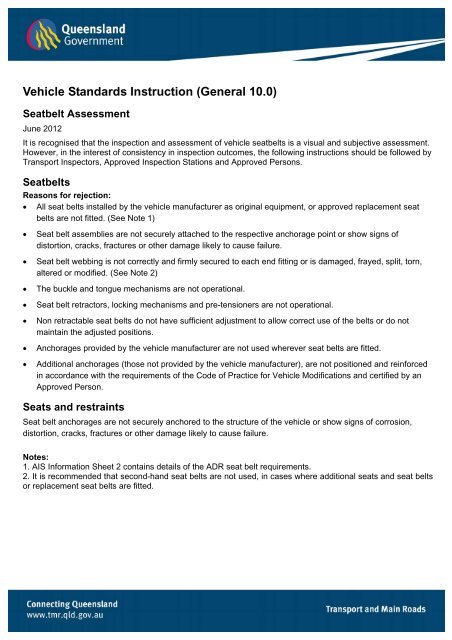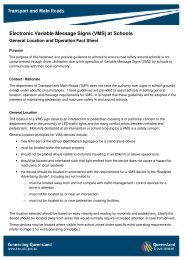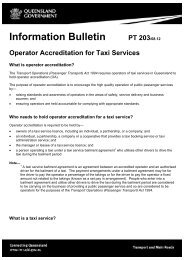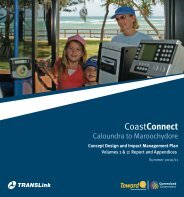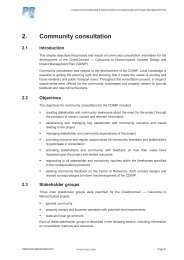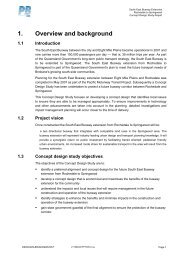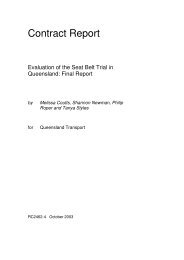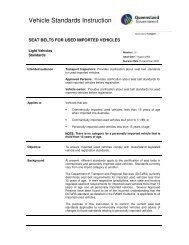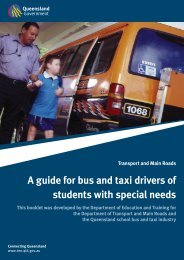VSI G 10.0 Seatbelt Assessment
VSI G 10.0 Seatbelt Assessment
VSI G 10.0 Seatbelt Assessment
You also want an ePaper? Increase the reach of your titles
YUMPU automatically turns print PDFs into web optimized ePapers that Google loves.
Vehicle Standards Instruction (General <strong>10.0</strong>)<br />
<strong>Seatbelt</strong> <strong>Assessment</strong><br />
June 2012<br />
It is recognised that the inspection and assessment of vehicle seatbelts is a visual and subjective assessment.<br />
However, in the interest of consistency in inspection outcomes, the following instructions should be followed by<br />
Transport Inspectors, Approved Inspection Stations and Approved Persons.<br />
<strong>Seatbelt</strong>s<br />
Reasons for rejection:<br />
� All seat belts installed by the vehicle manufacturer as original equipment, or approved replacement seat<br />
belts are not fitted. (See Note 1)<br />
� Seat belt assemblies are not securely attached to the respective anchorage point or show signs of<br />
distortion, cracks, fractures or other damage likely to cause failure.<br />
� Seat belt webbing is not correctly and firmly secured to each end fitting or is damaged, frayed, split, torn,<br />
altered or modified. (See Note 2)<br />
� The buckle and tongue mechanisms are not operational.<br />
� Seat belt retractors, locking mechanisms and pre-tensioners are not operational.<br />
� Non retractable seat belts do not have sufficient adjustment to allow correct use of the belts or do not<br />
maintain the adjusted positions.<br />
� Anchorages provided by the vehicle manufacturer are not used wherever seat belts are fitted.<br />
� Additional anchorages (those not provided by the vehicle manufacturer), are not positioned and reinforced<br />
in accordance with the requirements of the Code of Practice for Vehicle Modifications and certified by an<br />
Approved Person.<br />
Seats and restraints<br />
Seat belt anchorages are not securely anchored to the structure of the vehicle or show signs of corrosion,<br />
distortion, cracks, fractures or other damage likely to cause failure.<br />
Notes:<br />
1. AIS Information Sheet 2 contains details of the ADR seat belt requirements.<br />
2. It is recommended that second-hand seat belts are not used, in cases where additional seats and seat belts<br />
or replacement seat belts are fitted.
<strong>Seatbelt</strong> Safety Checklist<br />
Tongue and Buckle Assembly<br />
Check the engagement of tongue and buckle<br />
� The buckle and tongue assembly should securely latch together with no freeplay (limited movement)<br />
� The tongue should eject actively when released<br />
� There should be no visible cracks on the buckle and the buckle cover must be intact<br />
� The tongue should have no metal deformation, webbing marks, or visible cracks on metal or plastic<br />
sections<br />
Retractor<br />
� Pull the belt out as far as it will go then release it. The belt should return all the way to the retractor without<br />
sticking, gripping or stalling<br />
� The retractor should lock if the webbing is pulled out suddenly.<br />
Webbing<br />
� The webbing should be securely attached to its end fittings displaying no stretching or pulled stitching<br />
� The webbing should be flat throughout its entire length<br />
� Look for plastic burn marks, frayed stitching and any signs of rippling<br />
� Look for severe fading as exposure to sunlight could possibly reduce the strength, this could be apparent<br />
as visible degradation of the webbing fabric.<br />
Anchorage<br />
Ensure all anchorages are free from corrosion and securely fastened to the vehicle structure and all mounting<br />
points should not show any signs of deformation<br />
Look for the danger signs:
Transport Inspector’s action<br />
If a seatbelt assembly is assessed as unsafe, issue a Defect Notice.<br />
AIS action<br />
If a seatbelt assembly is assessed as unsafe, do not issue a Certificate of Inspection.<br />
Appendix A contains typical recommended instructions from seatbelt manufacturers and pictorials for<br />
guidance.<br />
Appendix B contains more pictorials of frayed and/or fluffed seatbelts that qualify for classification as Major<br />
Defects.<br />
Also note the following requirements from Australian Design Rules for proper care and maintenance of<br />
seatbelts:<br />
’Care should be taken to avoid contamination of the webbing with polishes, oils and chemicals, and particularly<br />
battery acid. Cleaning may safely be carried out using mild soap and water. The belt should be replaced if<br />
webbing becomes frayed, contaminated or damaged.’<br />
Supporting documents<br />
Second Edition Australian Design Rules<br />
Third Edition Australian Design Rules<br />
Approved Inspection Station Code of Practice<br />
Recommended practices by seat belt manufacturers e.g. Autoliv, Klippan and Securon etc.<br />
For more information please contact<br />
Vehicle Standards & Regulation Unit<br />
Email: vehiclestandards@tmr.qld.gov.au<br />
Phone (07) 3114 5844<br />
.
Appendix A<br />
Recommended instructions from a seatbelt manufacturer and pictorials for guidance.<br />
Courtesy – Klippan Safety Products
Appendix B<br />
Examples of frayed and/or fluffed seabelts that can be assessed as Major Defects (for guidance only).<br />
Fraying / Damaged Fibres<br />
Nick / Damaged Fibres<br />
Rippled / Damaged Fibres / Edge Nicks<br />
Fraying / Damaged Fibres<br />
Rippled / Damaged Fibres / Edge Nicks<br />
Fraying / Edge Fibres Damaged
Fraying / Edge Fibres Damaged<br />
Fraying / Nick<br />
Fraying / Edge Fibres Damaged<br />
Chaffing / Stretch


